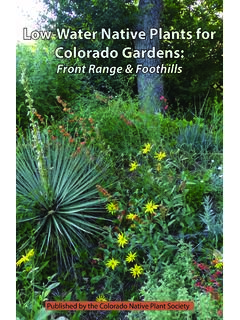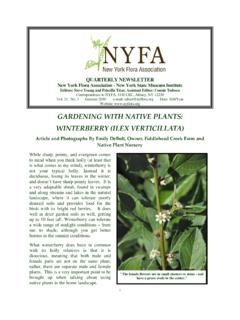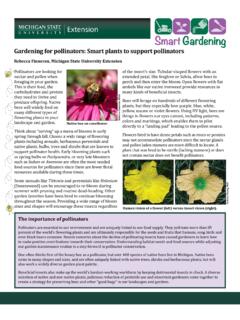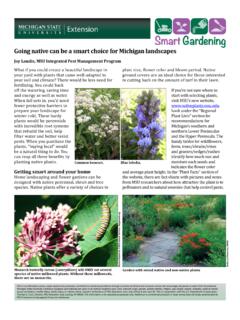Transcription of MISC0273 Grow Your Own Native Landscape - gridserver.com
1 A Guide toIdentifying,Propagating& Landscapingwith WesternWashington Native PlantsMISC0273 grow your OwnNative LandscapeWritten & Edited by Michael LeighAbout the Native Plant Salvage ProjectThe WSU Extension Native Plant Salvage Project began in 1994 to involve Thurston County residents in direct action to protect water resources and improve habitat. Through action projects and educational activities to people of all ages, the Project works to preserve existing vegetation, restore compromised habitat, revegetate habitats as diverse as prairies and marine shorelines, and reduce the impacts of stormwater runoff. The Project depends on hundreds of volunteers and landowners eager to make a difference to protect water its auspices, WSU NPSP has produced publica-tions and videos on revegetation, proper planting techniques, building rain gardens, low-impact devel-opment, and multi-season plant identification.
2 For more information, see and , or email: for this project was provided by the Environmental Protection Agency, the Washington State Department of Ecology, and Washington State University publication contains material written and pro-duced for public distribution. You may reprint material, provided it is sold at cost and not used commercially. Please reference the title and credit Native Plant Salvage Project, WSU Extension Thurston County. To reproduce material used with permission (such as illustrations) to create a new publication, please contact the original source noted in the may order copies of this and other publications from the WSU Publications office,1-800-723-1763, or online of ContentsWhy This Guide.
3 1 How To Use This Guide ..1 Part I. Introduction to Native plants ..2 What Are Native plants ?Why Use Native plants for Landscaping?When Is a Native Plant NOT Native ?Part II. Which Native plants Should I Use? ..3 Part Ill. How Can I Get Native plants ? ..6 Nurseries & Other Commercial Sources ..6 The Ethics of Collecting Native Plant Materials ..7 Growing from Seed ..8 Hardwood Cuttings ..10 Live Stakes ..11 Root Cuttings ..12 Rhizome Cuttings ..12 Layering ..13 Dividing plants ..13 Transplanting Suckers ..13 Salvaging Native plants ..14 Planting ..17 Part IV. Native Plant Descriptions ..18 Trees ..20 Shrubs ..43 Ferns, Ground Covers, & Herbaceous Perennials ..67 Emergent plants ..83 Submerged & Floating-leaved plants .
4 90 Part V. Problem Aquatic and Terrestrial plants ..98 Part VI. Lakes and Aquatic plants ..111 Lake AgingAquatic Plant BenefitsAquatic Plant ManagementContacts and Other ResourcesPart VII. Resources and Further Reading ..113 Part VIII. Glossary ..114 Part IX. References ..115 Part X. Index to Species ..116 Special thanks to the King County Water & Land Resources Division, who has joined with us in reprinting this second edition and whose guides Aquatic plants : Identification, Benefits, and Management, Noxious Weeds: A Guide to Invasive Non- Native plants , and Northwest Native plants : Identification and Propagation for Revegetation and Restoration Projects served as the basis for parts of this guide.
5 This last document, and King County s Native Plant Salvage Program, have served as models for similar programs in western Washington and around the nation. Our thanks for permission to extensively revise these publications for this guide. Those wishing to contact the King County program should call (206) appreciation goes out to Mary Jo Buza for permission to use Native Plant Associations for the Landscape , an excerpt from her Masters in Environmental Studies thesis completed in 1995 at The Evergreen State gratitude goes out to our reviewers: Clayton Antieau (WSU Extension/ Jefferson County); John Brown Jr. (Judd Creek Wetland and Native Plant Nursery, Vashon); Susan Buis (Sound Native plants and Sound Ecological Services, Olympia); Sheila Englehardt (Thurston Conservation District); Mary Fries (Washington Native Plant Society); Deanna Hamilton; and Jenifer Parsons and Kathy Hamel (Washington Department of Ecology, Olympia).
6 AcknowledgmentsThis guide is dedicated to Kit Paulsen, for her inspiration and commitment, and to the volunteers who have ensured the success of the Thurston County Native Plant Salvage second edition is dedicated to the thousands of volunteers, workshop participants, and users of this guide who have worked to make the Native Plant Salvage Project successful by putting more Native plants in landscapes throughout Thurston County and western are grateful to our many advisory committee members, from 1994 to 1999: Ben Alexander and Susan Buis, Sound Native plants ; Robert Barnes and Theresa Dukes, Washington State Dept. of Transportation, Olympic Region; Leonard Bauer, City of Tumwater; Matt Bennett, Coot Company; Kathleen Bucher, Project Volunteer; Jared Burbidge, City of Lacey Water Resources; Mary Jo Buza, Gardens by Design; Brent Chapman, South Puget Sound Community College; Robert Connolly, Skillings-Connolly, Inc.
7 ; Sandra Drake, Thurston County Master Gardener Foundation; Sheila Englehardt, Thurston Conservation District; Christopher Hawkins, YMCA Earth Service Corps; Monica Hoover, Natural Resources Conservation Service; Steve Jenks, Washington Dept. of Fish and Wildlife; John Konovsky, Thurston Conservation District; Beth Leimbach, Project Volunteer; Lame McLaughlin, Washington Native Plant Society; Rick Moore, Sasquatch group, Cascade chapter, Sierra Club; Nalini Nadkarni, The Evergreen State College; Niven Richardson, Master Gardener Foundation; Suzanne Shafer, John L. Scott Real Estate; Bob Simmons, WSU Extension; Bob Smith, WSU Extension, Thurston County; Craig Steepy, S. Chamberlain and Associates; Gina Suomi, Project Volunteer; DorothyTaylor, Project Volunteer; Carolyn Trefts, Project Volunteer; Margaret Tudor, Washington Dept.
8 Of Fish and Wildlife; Susie Vanderburg, Thurston County Stream Team; Lauri Vigue, Black Hills Audubon Society; Cedar Wells, City of Olympia Water Resources; Don Willson, City of Lacey Water warm thanks go to Susan Buis for providing considerable assistance writing the sections on propagation; to Jenifer Parsons and Kathy Hamel for providing similar services for the sections on aquatic plants ; and to Clay Antieau for thorough and helpful proofreading of the first the first edition: Clip art assistance was provided by Raul Dunn of Thurston County Community and Environmental Programs; emergency computer programming assistance was provided by John Konovsky of the Thurston Conservation District; editing and layout assistance for the first edition was provided by Kathleen Bucher, Ernie Paul, and Bob Simmons; office support was provided by the WSU Extension/Thurston County office the second edition, we are grateful to: Melanie Ransom, our Water Resources Program colleague, for her diligence and patience in converting the document from one system to another; to Scott Stevens, master of detail, who spent countless hours editing and entering changes; to Linda Greer Design; to Kevin Svara, Intern Extraordinaire, who produced original illustrations for icons to complement the existing style.
9 To several members of the Master Gardener Class of 1999, for miscellaneous computer and proofreading assistance: Dawn Hamilton, Tom Howdeshell, Pam Ness, Velma Rogers, and Linda Lee Treece; to Eli Sterling & Earthbound Productions for sharing their computer; and to Ernie Paul, Native Plant Salvage Project Coordinator from 1994 to Credits (all drawings used with permission; numbers refer to page in this document where the illustration is used)Hitchcock, C. Leo, Arthur Cronquist, Marion Ownbey, and J. W. Thompson. 1969. Vascular plants of the Pacific Northwest. University of Washington Press, Seattle, Washington (illustrations by Jeanne R. Janish): all plant illustrations except for those listed , Helen M.
10 And Patricia L. Packard. 1962. Winter Twigs: Northwest Oregon and Western Washington. Oregon State University Press, Corvallis, Oregon (twig illustrations): 21, 22, 23, 24, 27, 28, 29, 30, 34, 35, 37, 38, 45, 46, 48, 50, 52, 53, 54, 56, 58, 59, 60, 62, 63, 64, , Lewis. 1985. Secrets of Plant Propagation, Storey Communications, Inc., Pownal, Vermont (illustrations by Elayne Sears): Cover (right side), 6, 8, 10 , 12 (top), 13 (middle), , R. C. Native Trees of Canada, 7th edition. 1969. Canadian Forest Service, Ottawa, Canada (tree silhouettes): 22, 25, 26, 29, 31, 32, 36, 37, 40, 41, n, Eric. 1968. Flora of Alaska and Neighboring Territories: A Manual of the Vascular plants . Stanford University Press (permission by the Board of Trustees of the Leland Stanford University): Office of the University of Florida, IFAS, Center for Aquatic plants .









